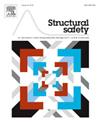加性泊松白噪声下KF方程和RDKF方程的单元重归一化解
IF 6.3
1区 工程技术
Q1 ENGINEERING, CIVIL
引用次数: 0
摘要
泊松白噪声是各种工程应用中经常出现的噪声。因此,求解泊松白噪声激励下结构的随机动力响应是一个重要的研究挑战。本文利用Kolmogorov-Feller (KF)方程和降维KF (RDKF)方程,提出了一种确定响应概率分布的高效数值方法。该过程首先利用随机谐波函数产生泊松白噪声,然后计算结构的动力响应。然后采用单元重归一化方法计算每个单元中心的微分矩。在此基础上,利用高斯过程回归(GPR)对状态空间内的连续微分矩曲线或曲面进行建模。最后,将路径积分解应用于求解KF和RDKF方程,最终得到所需的结构响应概率分布。为了突出所提出的方法的优点,采用了一系列数值实例,包括一维和二维场景,线性和非线性系统,来证实所提出方法的适用性。本文章由计算机程序翻译,如有差异,请以英文原文为准。
The cell renormalized method for the solution of KF equation and RDKF equation under additive Poisson white noise
Poisson white noise is frequently occurring in various engineering applications. Consequently, solving the stochastic dynamic response of structures subjected to Poisson white noise excitation constitutes a crucial research challenge. In this paper, using the Kolmogorov–Feller (KF) and reduced-dimensional KF (RDKF) equations, a highly efficient numerical approach is proposed for determining the probability distribution of the response. The process begins by generating Poisson white noise using stochastic harmonic function and subsequently computing the dynamic response of the structure. The cell renormalized method is then employed to compute the derivate moments at the centers of each cell. Following this, Gaussian Process Regression (GPR) is utilized to model the continuous derivate moments curve or surface within the state space. Finally, the path integral solution is applied to solve the KF and RDKF equations, ultimately yielding the desired probability distribution of the structural response. To highlight the advantages of the proposed methodology, a series of numerical examples, including one and two dimensional scenarios, linear and nonlinear systems, are all employed to substantiate the applicability of proposed method.
求助全文
通过发布文献求助,成功后即可免费获取论文全文。
去求助
来源期刊

Structural Safety
工程技术-工程:土木
CiteScore
11.30
自引率
8.60%
发文量
67
审稿时长
53 days
期刊介绍:
Structural Safety is an international journal devoted to integrated risk assessment for a wide range of constructed facilities such as buildings, bridges, earth structures, offshore facilities, dams, lifelines and nuclear structural systems. Its purpose is to foster communication about risk and reliability among technical disciplines involved in design and construction, and to enhance the use of risk management in the constructed environment
 求助内容:
求助内容: 应助结果提醒方式:
应助结果提醒方式:


